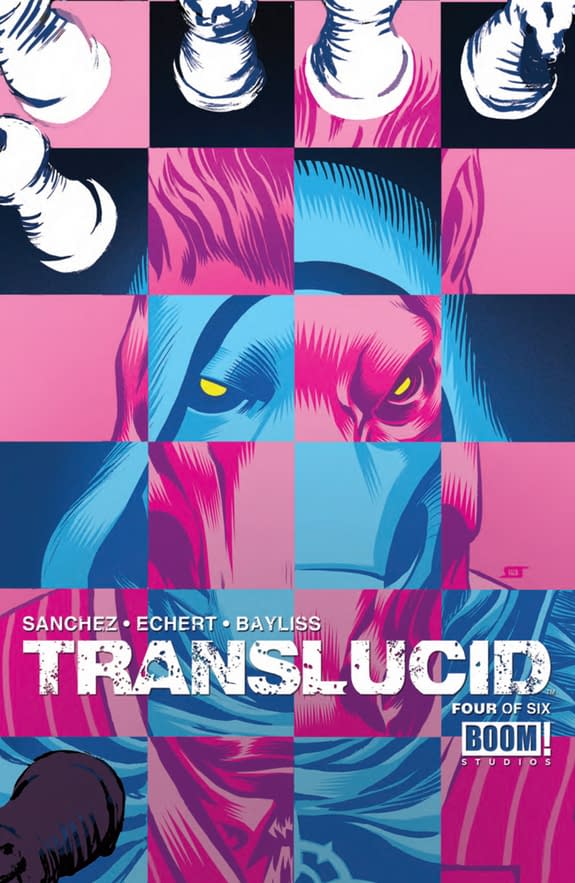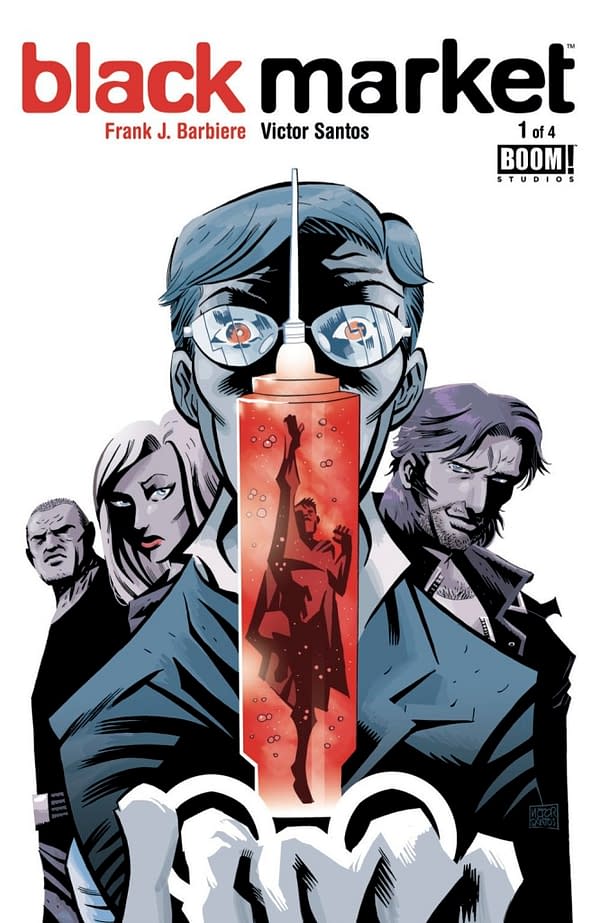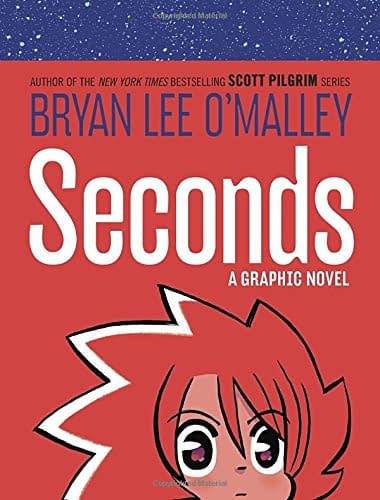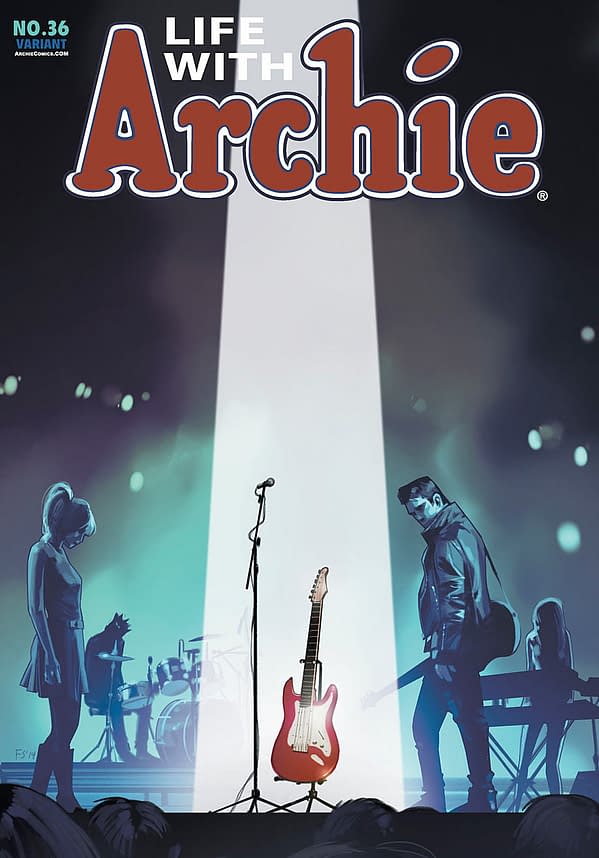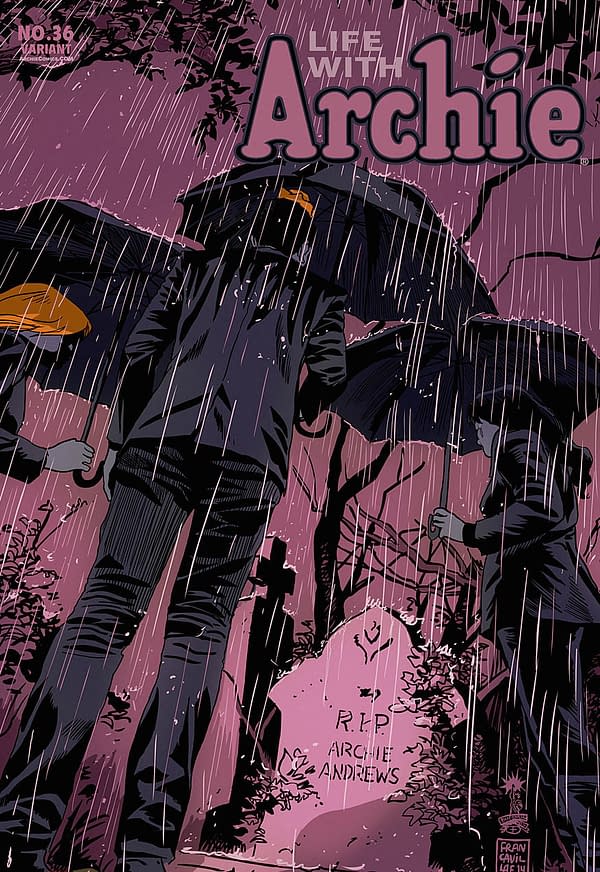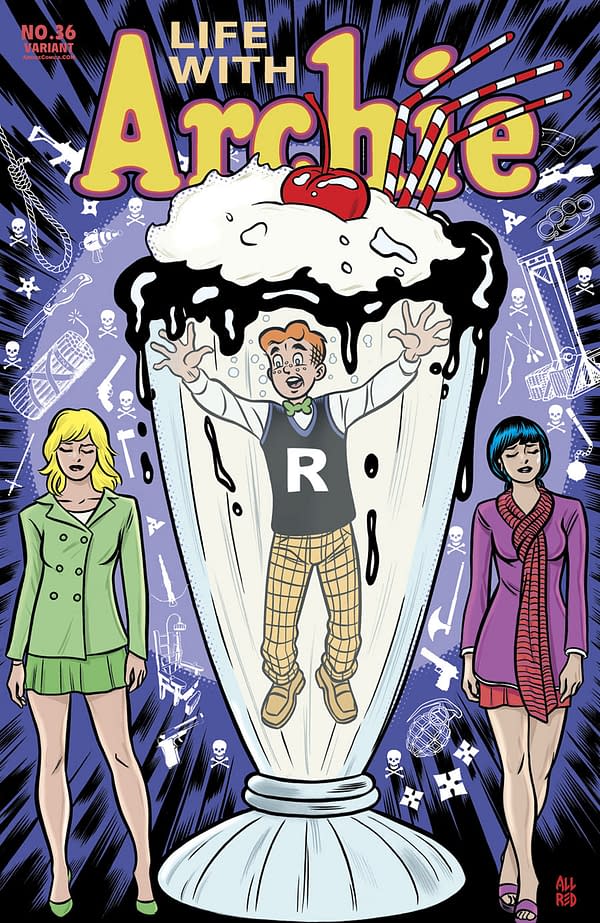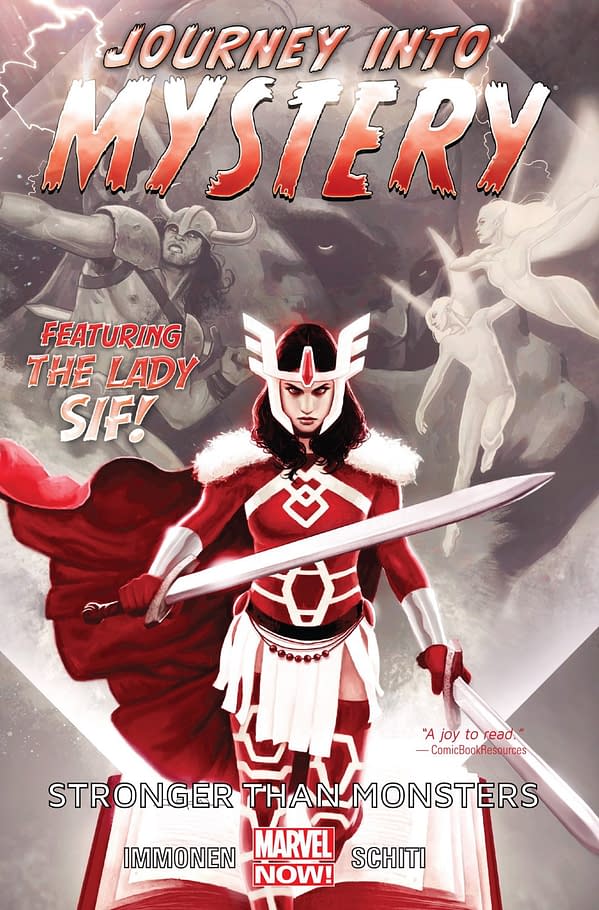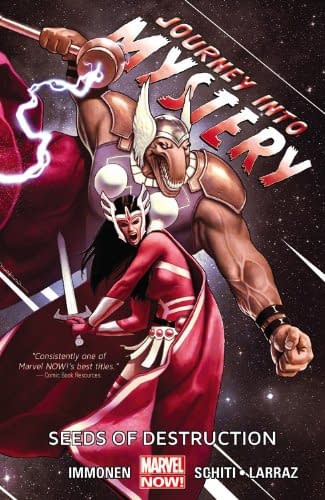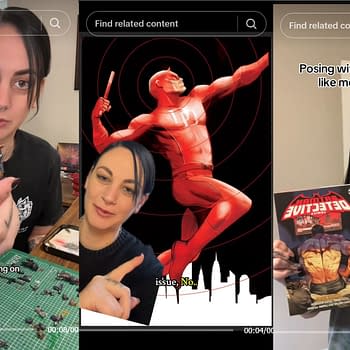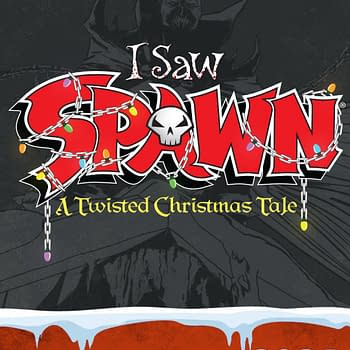Posted in: Comics, Recent Updates | Tagged: black captain america, Black Market, boom studios, bryan lee o'malley, Comics, dark engine, dc comics, entertainment, female Thor, Frank Barbiere, image comics, journey into mystery, life with archie, Marvel Comics, Paul Kupperberg, seconds, teen titans, Translucid
Thor's Comic Review Column – Teen Titans, Dark Engine, Translucid, Black Market, Seconds, Life With Archie, Journey Into Mystery: Sif, And A Few Words For Those Who Can't Handle Change In Funnybooks
This Week's Comic Reviews Include:
Teen Titans #1
Dark Engine #1
Translucid #4
Black Market #1
Seconds
Life With Archie #36
Journey Into Mystery Featuring Sif Vol. 1 and 2
But first, a word or two directed to those who can't handle change in their superhero funnybooks.
1. An Open Letter to People Complaining About the New Thor/Captain America
By Adam X. Smith
Disclaimer: I recognise that the following opinion is my own and not that of my fellow members of Thor's Comic Column, or that of Bleeding Cool or anyone else associated with it, and I take full responsibility for any insult this op-ed may cause and that my editors reserve the right to pull this piece should they feel compelled to do so. However, in the interest of journalistic integrity, I ask that, should they decide to run the piece, that it remains uncensored and unedited. It is not for my own morbid amusement that I write this, but because, in my own silly, ignorant and self-aggrandising mind, I want to save you all from yourselves.
Because I'm awesome like that. True story.
So much for Objective Journalism. Don't bother to look for it here — not under any byline of mine; or anyone else I can think of. With the possible exception of things like box scores, race results, and stock market tabulations, there is no such thing as Objective Journalism. The phrase itself is a pompous contradiction in terms. – Hunter S. Thompson
So anyway…
This week Marvel announced a radical change – you've probably already heard about it. Apparently Thor is a woman now. And Captain America is black. Details are relatively scant, accept to say that the new Cap is actually Sam Wilson aka Falcon, indicating that Marvel haven't completely taken leave of their senses and decided to do a Soul Man and turn old blond-hair- and-blue-eyed Steve Rogers into a black guy (thank Satan for that).
As with so many other moderate-to-large changes to mainstream comic continuity, this is part of a crossover scheduled for later in the year, and like Loki's brief stint as a woman (which admittedly had a precedent because Norse mythology is fucking weird), Captain America's "death" at the conclusion of Civil War, or indeed any of the hundreds of comic book deaths that have occurred in the just over 20 years since Superman famously died, was replaced and then came back within the space of a year, chances are it will probably be forgotten, remembered only briefly by a handful of fans and dismissed from the collective consciousness just as quickly.
The internet, of course, is a completely different story, and people all over the web reacted about as well as you'd expect.
Let me be clear – I am neither for nor against these changes. I have neither an axe to grind nor a horse in this race. My only concern when it comes to changing the status quo in comic books is whether or not it is interesting. If it is not interesting, then I won't be compelled to read the books, and therefore it is pointless. I have no clue whether making Thor temporarily female or Captain America temporarily black will make me more inclined to read their books – for me it is neither a deal-breaker nor a deal-maker. However, it is Marvel's prerogative to shake things up every now and again, the same as it is DC's. However shortlived the changes may be, creativity is a means to its own ends, and whatever comes of this experiment is valid on its own merits.
However, for those people who believe that changing these characters in and of itself is some sort of betrayal of the audience's suspension of disbelief; the people for whom no historical precedent exists for making Thor or Captain America, two characters that are the product of a writer and an artist's imaginations, anything different from what they were the last time the happened to skim-read a comic or see them on film or TV or in a video game; the ones that feel these characters are somehow so sacrosanct that to portray them as anything other than blond-haired-blue-eyed Aryan übermenschen offends their tastes…
To these people, I have one thing to say: grow the fuck up. I am officially done with anyone who attempts to justify hating changes to established characters purely because it's different or alternative or ethnically/sexually diverse. You people – and I'm not going to pretend you're a "vocal minority" or "a few bad apples" – are the reason we can't have nice things, and if I had my way you'd all be beaten with loaded sticks and left bleeding in the moonlight. You are the not-so-silent majority, and you've officially pissed me off.
Where was this bellicose rabble protesting changes to a character's appearance and personality when Batgirl recently got made over as a Doc Marten-shod hipster? Where was all the righteous indignation from these people over the cheapening of the brand when Batwoman's wedding to her fiancée was nixed by DC editorial for reasons that are incredibly stupid, or when Harley Quinn or Wonder Girl or Starfire or indeed most of the women at DC were dragged down to the level of softcore porn stars in the name of entertainment? What about the increased ghettoization of Vertigo due to the mandate that all DC characters play in the New 52 sandbox from now on? Do any of these stunted jackoffs care about that? Do you suppose that previous generations of fans in the 1950s and 60s sent in angry letters complaining that replacing Jay Garrick and Alan Scott as Flash and Green Lantern was ageist and "political correctness gone mad"? Give me a fucking break.
Okay, fine – some people, indeed a lot of people in some cases, have pushed back on those things, and people are pushing back with the Thor/Cap . Graeme McMillan at Wire suggests that it doesn't go far enough. And thank the mighty Atheismo above that they are. The internet can be harnessed for both good and evil, after all. I know that is not good ethics or objective journalism to suggest that the group of people who care about the state of racial/gender diversity and representation within comics and those who choose to spend their time complaining about the new Thor and Cap are mutually exclusive, even if that's what I personally believe. I leave it to you, the reader, to discern for yourselves which is more likely to be true. How's that for objectivism?
Let's put it this way: In thirty years of reboots, retcons and reimaginings, DC has never once come up with a consistent backstory for Hawkman. The reason you don't see massive flame wars on the internet about how this ruins the continuity is because people only care about the things they think are significant.
To those arguing over strictly P.C. lines, don't bother getting up. You'll only embarrass yourselves. You're the same people who stirred up grief when Ms. Marvel was recast as a Muslim girl and when Idris Elba was cast as an Asgardian. You have not one leg to stand on, and your opinions do not stand up to even the barest of scrutiny. That's not me being a bleeding heart-liberal-commie-soicalist-humanist-faggot. That's me being a decent human being – you might try it some time.
Comic book companies change things for one reason only – to get more people reading them, and most of the time it works like gangbusters. Whatever justification people come up with for shitting on this change – before it's even seen print, no less –and whether or not their position hinges on anything more than ignorance and stupidity (spoiler alert: it doesn't), every argument for or against this whole business falls at the feet of one single shred of objective fact.
Wanna know what it is?
Here it comes.
It doesn't exist. It's not real.
Fine, someone had to come up with it, someone designed it, but as with all comic book canon and trivia, it is subject to continuity, and therefore exists at the mercy of the retcon, the Great Equaliser. The Mighty Retcon giveth and the Mighty Retcon taketh away just as easily. Marvel is not as quick to hit the reset button as DC – they're notorious for building a cottage industry just out of understanding the shared history from decade to decade – but some day you can better your ass they'll give it a go. It'll probably be a softer reboot than most, with a lot less collateral damage, but they'll do it nonetheless. So any bitching about what is going on now or in the near future hardly matters, does it? Before you know it, the universe will get rebooted back to tabula rasa and everything you don't like will just vanish in a puff of logic. Same as it ever was.
I know I'm howling into the abyss on this one – my fury is as pointless as the arguments themselves. Of course people are going to continue whining and moaning. Of course this change will come and go. I too will live to see this rant fade from people's memory.
However, there is one perspective I failed to account for, and I think it's one we're all better off remembering.
A whole bunch of little kids can now play as Cap or Thor without weird looks, so maybe it's not all about how bitter you are this time? — Writer and artist Jason Latour, Wolverine and the X-Men, Edge of Spider-Verse, Southern Bastards, The Winter Soldier
Sometimes it's worth reminding ourselves what's important. Also, it comes to something when Archie dying whilst taking a bullet to save his gay, pro-gun control, war vet politician friend from a gun advocate slips under the radar.
My name is Adam X. Smith, and I am burdened with glorious purpose.
Adam X. Smith is a paranoid android from the Planet X. For the last 27 years he has been living amongst the people of Birmingham, England (and more recently the University of Lincoln) ostensibly as a student of the school of hard knocks (also BA Hons Drama), but secretly on a mission to scout out the planet for invasion by alien forces; his weekly communiques on his various blogs are actually highly coded messages to his extra-terrestrial masters. He enjoys the musical stylings of local chiptune-metal band Elmo Sexwhistle, the fiction of Kim Newman, Kurt Vonnegut and Chuck Palahniuk, and his hobbies and interests include film-making, drama, occasional Youtubing, journalism and plotting the subjugation of humanity. He can be found on Youtube, Tumblr, Twitter or by jamming an ice-pick through the optic chiasm.
2. Teen Titans #1 (DC Comics, $2.99)
By Devon Sanders
Two weeks ago, for nostalgia's sake, I bought the first trade paperback of Geoff Johns' Teen Titans run.
I read it and all it did was make me nostalgic for a time when Tim Drake was Robin. No going back and forth from DC Comics on whether or not he was a Robin; no, Tim Drake was THE Robin. Impulse evolved, embracing legacy and became Kid Flash. In Johns' Teen Titans, Superboy finally was something more than one of the final remnants from The 90's "Death Of Superman" arc and Wonder Girl, through trial and fire, more than earned her spot. Teen Titans was a book about legacy and I bought in, wholeheartedly. Johns did such a great job of showing us who these characters were, I even began referring to them by first name.
Fast forward, two weeks and a new Teen Titans book is on the stands, written by one of comics' most underrated writers, Will Pfeifer (Seriously, go find his six issues of Aquaman. NOW.) and drawn by one of DC's up and coming superstars, Kenneth Rocafort.
Make no mistake about it, this is very much a showcase book and DC wants your eyes on it. Question is: are you in?
Teen Titans #1 opens with a bus full of children and a bomb set to go off in the middle of Times Square. There's a new terrorist group in DC's New 52 and S.T.A.R. Labs is their target. All that stands in their way is a group of superpowered teens (minus a Kid Flash) who may or may not be a team anymore.
Pfeifer does a good job of establishing who these young heroes are within the 20 pages he has to work with. His Titans are capable and assured, especially his Beast Boy. Under Pfeifer, he comes across as battle tested and ready for whatever's to come. The dialogue, at times, can be a bit expository but in this, Pfeifer manages to intrigue with nice character bits and interaction and a threat within S.T.A.R. Labs that will make fans of writer Joe Kelly's classic Superman story, "What's So Funny About Truth, Justice and The American Way" stand up and truly take notice.
OK, let's just get it out of the way; artist Kenneth Rocafort's Wonder Girl is sorta… ridiculous. Gossamer hair seems to be one of her many superpowers and I wish he'd given as much thought to her body type and bearing as he does to Red Robin or Beast Boy. I do. Rocafort's art, itself, is striking but stiff in places and I suspect this has more to do with having to tell a lot of story in only so many pages.
The results… well, it's not Johns' Titans anymore. If you're looking for legacy, you won't find it here. What you will find is a book full of characters coming into their own and in many ways, that can be as powerful as legacy.
Fingers crossed.
Devon Sanders is a menace. Plain and simple; a menace. Has the common sense of a brick. Writes good, though.
3. Dark Engine #1 (Image, $2.99)
By D.S. Randlett (@dsrandlett)
Last year, Monte Cook published the tabletop role playing game Numenera. I had never gotten into the hobby much before, but I found myself intrigued by the game's promise of a far future world that was inspired by the likes of Moebius and Kamandi and shared some strands of DNA with Brandon Graham's Prophet. So, I would check out the book, and then find myself GMing a game for a group of far flung college friends of mine. While this has had the benefit of rekindling and maintaining some strong bonds, being in the GM position has forced me to live with the game and its world. A large part of Numenera's world is what Cook has dubbed "The Weird." As a GM for my group, I find myself thinking about this idea a lot, as it is what gives the game its distinct feel. The problem I'm often faced with when preparing a game session is how to cultivate this feeling at the table, how to present my friends with ideas that are in part recognizable in some sense, yet completely unknowable in others.
As such, I've also been thinking about The Weird in art lately, especially comics. Really, this is Jodorowsky's bread and butter. His and his collaborators' work is often purposefully barely comprehensible. The end result is gonzo science fiction with a more poetic sensibility that allows extreme ideologies and feeling to clash off one another, and Jodorowsky's take on The Weird would go on to define a certain kind of European comic. Unfortunately, this stream of narrative style never really escaped its niche in American comics until Prophet relaunched in 2012 under the pen of Brandon Graham. Graham's current opus started as a sort of far future version of a Jack London survival story. Full of silent brutality and creatures of unknowable evolution who the title character by turns ate or had sex with. The Weird was in full force, and part of the appeal of those earlier stories was watching the stoic protagonist just brush all of this off. Since then, Prophet has ratcheted everything up from the action to, yes, The Weird. And it's been something of a success.
Dark Engine, written by John Bivens with art by Ryan Burton, is following in Prophet's footsteps into The Weird. And friends, is it ever fucking Weird. Much like Prophet, the sheer silence of Dark Engine goes a long way toward achieving that feeling. Much of the story unfolds solely through Burton's art, at once gorgeous and grotesque, and at that end of things we are in quite good hands. The dark fantasy is brought to life with thick lines that accentuate the horror of the sheer amounts of gore on display. At this point it's hard to really say what this book is about, which is part of the point with this first issue, but if I had to pigeonhole it right now I'd describe it as David Cronenberg's Red Sonja. The art gets that feeling across perfectly, with everything from the line style to the panel layouts contributing to both a sense of disorienting weirdness and crushing violence.
Bivens' writing is pretty sparse, but there are some missteps. He splits the book's perspective up into three different points of view. While this is narratively valid, it ends up muddling this issue's flow somewhat and making what little exposition there is not quite satisfactory. It involves alchemists, demons, and body horror time travel, which is all good stuff, but it seems as if Bivens wants to hook readers with his take on The Weird here and the scenes of exposition break up that flow. The writing is never bad, but the attempts at mythology building break up the otherwise sound and compelling narrative. The demons and the alchemists, while likely essential to the forthcoming plot of Dark Engine, might have been able to wait until issue #2. But it's entirely possible that as we get more of this story ,these complaints will be entirely mute. The fact is that both Bivens and Burton have created a compelling and brutal world, and I want to spend more time there.
If you like being immersed in The Weird, Dark Engine is well worth checking out. If you're just looking to dip your toes in, maybe start with Prophet #21 while waiting for a few more issues of this to come out.
D.S. Randlett lives in the hills of Virginia and takes credit for the reviews that his emaciated twin brother writes while chained to the old radiator. He plays his guitar while biding his time for unsuspecting tourists and thinking about going to grad school.
4. Translucid #4 (Boom!, $3.99)
By Cat Taylor
A few months ago I wrote a pretty favorable review of Translucid #1 for this column. The first issue showed amazing potential for a superhero limited series. While it didn't appear that it was going to be as groundbreaking as Watchmen, Astro City, or the Dark Knight Returns, the book was cut from the same cloth. The first issue made it clear that the writers, Claudio Sanchez and Chondro Echerti were focusing on the psyches of the series main hero and villain rather than cool superpowers and over-the-top action. That first issue ended with a pretty neat surprise that let the reader know Sanchez and Echerti found some twists and motivations that have rarely, if ever, been thoroughly explored in superhero comics. As a result, I was eager to see where the second issue would take the story. However, the second issue was mostly a flashback story, delaying my satisfaction yet another month. By the time the third issue came out I was thinking about potato chips or something. What can I say? It's the digital age and our ability for instant gratification has shortened almost everyone's attention span. Such may be the case but with issue #4 now available, I thought it was time to check back in on the series.
Like issue number two, number four is also primarily told in flashback. The focus of this story provides more insight into the childhood of the world's number one hero, Navigator. To say that the Navigator had a difficult childhood is an understatement. There's so much existentialism and depression in his background that I'm pretty sure both Albert Camus and Morrissey would say, "Okay, that's enough. I can't take anymore!" It's, in a word, overkill. That doesn't mean that it's a bad story or that the series has already been ruined. It just means that I wonder if it's necessary to have almost every element of Navigator's childhood so screwed up when one or two of those events could have been sufficient.
I know that one thing Alan Moore always lamented about the influence of Watchmen was how so many writers started turning out really depressing and disturbing stories thereby turning Watchmen from a deconstruction of the medium to the new normal. What I saw in the first issue of Translucid was a story that was going to some different places from the stereotypes in superhero and supervillain motivation. Issue number four, on the other hand, is focused on the clichéd psychologically damaged hero. So, the question remains, is this a case of throwing everything at the wall with the idea that more is better? The final two issues will have to resolve the pieces and pull them together but in my experience it's usually better to put a deeper focus on the more unique ideas rather than trying to do a little bit of everything. At any rate, if the reader hasn't figured it out by now, Navigator is a psychological mess despite being an effective hero, and it appears he might completely unravel by the end of the series. I'm rooting for Sanchez and Echerti to surprise and impress me with their conclusion.
That's my take on the story. Now, let's talk about the art. Daniel Bayliss is really talented. I assumed that he probably has a pretty impressive resume but my amateur internet research revealed that Translucid is his only published comics work. I know it's a competitive field but I expect he will see plenty of assignments in his future. Bayliss has a style that blends 1980s mainstream comics art with some similarities to Mike Allred and Bernie Wrightson into his own pop-art style.
Overall, the series so far started off really strongly and while I'm still hooked for rest of the haul, the issues since number one have flat-lined rather than increased my anticipation from issue to issue like the absolutely best comic mini-series do. I think one misstep was alternating each issue from mainly present day to flashbacks. The flashbacks are necessary to understand the characters but having such a huge focus on them in alternating issues really slowed the momentum that was established in the first issue. With only two issues left, things are at critical mass. Either the last two issues are going to wrap things up and be a big pay-off from the promise of the first issue or they'll fizzle into predictable territory and disappointment.
Cat Taylor has been reading comics since the 1970s. Some of his favorite writers are Alan Moore, Neil Gaiman, and Kurt Busiek. Prior to writing about comics, Taylor performed in punk rock bands and on the outlaw professional wrestling circuit. During this time he also wrote for music and pro wrestling fanzines. In addition to contributing to Thor's Comic Column, Taylor also writes fast food fish sandwich reviews for Brophisticate.com. He has the dubious distinction of not having a Twitter account.
5. Black Market #1
By Bart Bishop
Writer Frank Barbiere has most recently written The White Suits for Dark Horse and a New Avengers Annual for Marvel, but this is my first experience with him. Artist Victor Santos, meanwhile, best known for his Filthy Rich with Brian Azzarello, is also new to me. Needless to say going in to Black Market is a fresh experience, from a company that isn't known for its focus on super heroes. Boom! Studios, in fact, isn't limited by a niche, instead presenting a grand diversity of creator-owned and adapted properties. Black Market is of the former variety, bringing a unique twist to the genre we're all familiar with. With a sensibility most comparable to Ed Brubaker and Sean Phillips' Sleeper and Brian Michael Bendis' Powers, Black Market promises to explore the darker side of the cape and cowl crowd, kicking off with an intriguing if predictable debut.
The story follows Ray Willis, a disgraced former medical examiner now working at a funeral home. His scandalous background is vague, but what's apparent is he tried to help his convict brother Denny at some point and ended up ruining his life. Now he toils along with a slave-driving boss and a wife, Shannon, living with multiple sclerosis, beaten down by existence. The setting is a modern-day Boston grounded by the mundane ennui of everyday life, except that there's also the Supers. Mirroring classic superhero tradition in a meta capacity, Golden Age costumed crime fighters cropped up years before only to be replaced by Silver Age-esque super-powered beings that have cleaned up crime but left the world's citizens changed forever. "Half of humanity worships them," narrates Ray. "But the other half? Not so forgiving." This is the backdrop, beautifully established in a one-page montage, for Denny to arrive at Ray's door with a deal: help him capture Supers to harvest their DNA for a pharmaceutical company called Biochem. Not only is there money in it, but the promise of rehabilitating their reputations and more importantly curing cancer, AIDS, and MS.
What's great is this world building is all background. At the foreground is the relationships. The entire thrust of the plot is predicated on character-based choices, with Barbiere wisely supplying just enough information for his audience to engage with and the rest being teased out, particularly the expected but still provocative cliffhanger ending. The issue itself is structured with a very modern, television-influenced in medias res methodology that jumps into the action only to back up for character introductions, interweaving the immediate future with the catalyst event that set things off. It's easy to see the DNA of such modern primetime series as Lost and Breaking Bad, with flash forwards creating a sense of dread out of onrushing inevitability. The characters themselves are straightforward but so far have unique personalities and voices: Ray is the downtrodden audience surrogate punished for acting in his family's best interest; Denny is the roguish scoundrel with questionable motives; and Albert is the good-natured muscle. It plays like a crime caper with a formula that allows for almost infinite possibilities (Ray and company kidnap another superhero, hijinks ensue) with the greater conspiracy of Biochem laying the groundwork for a serialized story.
The artwork by Victor Santos is very reminiscent of Michael Oeming by way of Mark Buckingham (Fables), which is appropriate considering Oeming did the art on The Mice Templar volume 1 and Santos took over volumes 2 and 3. Oeming, made famous by his collaboration with Brian Michael Bendis on Powers, pioneered a minimalistic style characterized by sharp edges and exaggerated features and body types. Santos picks up the ball and runs with it here, creating a stylish dichotomy between the classic subject matter of superheroes doing good deeds and the dark underbelly that the Willis brothers occupy. The cartoonish visuals, highlighted by a clever layout of panels occupying the page space efficiently and provocatively (see Ray working in the funeral home for a clever use of character perspective and implication for the sake of the audience's imagination), call back to the heroic worlds of Bruce Timm, but there's also an element of intimidation to the Supers, as Ray's narration informs us. Their power and distance is apparent in Santos' portrayals, with clever framing depicting angles with the heroes up above, always looking down on the proletariat.
A strong start that sets up the key players while leaving lots of room to grow. This is how to pull off a first issue, by stacking up the necessary elements so the first story arc and subsequent arcs can knock them down. Although there's nothing terribly new or fresh about the characters or the world just yet, they're fleshed out enough to be more than archetypes and their angle into this world is certainly different. I look forward to where Barbiere goes with this, and hope he and Santos continue to collaborate as they create pleasing synergies.
Editor and teacher by day, comic book enthusiast by night, Bart Bishop has a background in journalism and is not afraid to use it. His first loves were movies and comic books, and although he grew up a Marvel Zombie he's been known to read another company or two. Married and with a kid on the way, he sure hopes this whole writing thing makes him independently wealthy some day. Bart can be reached at bishop@mcwoodpub.com.
6. Seconds (Ballantine Books, $25.00)
By Joe Colewood
It must be really hard to write a monumental comics work that becomes a bestseller and cultural touchstone, ending up adapted into a beloved movie and making you lots of money.
Stop. Revise.
It must be daunting to write an immensely popular and significant comic. After the first thrill wears off, a creator is presumably dogged with the fear that they've now shot their wad, so to speak-that their biggest contribution to culture is now out there, and everything else they create will be an afterthought. As a creative person, the idea that your best work is now behind you is not a thought to inspire. And creative people don't really need any excuse to feel bad about themselves.
But any real artist knows ya gotta get back on that horse, whatever the results. And of course a real talent can do it with a double backflip and effortlessly pound out another terrific comic with a casual insouciance that seems to say, "Pooh, excellent comics? They fall from my hands like breadcrumbs from a pigeon-feeding hobo, no big thing, later haters" and then the horse spouts wings and flies off trailing rainbows. Bryan Lee O'Malley is a guy who can do this, and I HATE HIM SO MUCH-
Stop. Revise.
Bryan Lee O'Malley is a very talented guy, and I wish him long life and for his face not to be eaten by spiders before he can continue to make everyone in the comics industry look like a stupid hack.
Seconds is his follow-up to the quadruple-platinum-selling, Oscar-winning Scott Pilgrim series, and it sees him working once again in his own very specific sub-subgenre of carefully-observed slice-of-life character studies with romance and magic realism. The main character, Katie Clay, is an award-winning chef who's already found massive success and critical acclaim with her restaurant, Seconds, before she even turns 30. Autobiographical much, O'Malley? You don't have to friggin' rub it in–
Stop. Revise.
Katie's found success and is in the process of starting a new restaurant, Seconds, while finding it hard to let go of the old one-she still lives in the apartment above it, and is having an affair with the new chief cook, while mooning over her ex (non-evil) and feeling discombobulated about leaving her 20s behind. Then she discovers that Seconds has a "house spirit" named Lis, a weird blonde elf who wears thrift-shop castoffs and eats the bread left out by Hazel, one of the employees. Lis gives her access to a magic mushroom that allows her to undo one (1) mistake, and Katie promptly uses it to undo a chain of events she'd begun earlier that day that ended with Hazel being injured. Initially skeptical, Katie quickly becomes drunk on power when she discovers the source of Lis' mushrooms, and begins using them to undo more and more of her bad life choices, leading to increasingly radical shifts in the timeline. But not only do these "revisions" come with unexpected consequences-because of course they do-abusing the mushrooms invites problems of a more supernatural nature into Katie's world as well.
You've read Scott Pilgrim, of course you have, so you hardly need me to tell you that O'Malley is a cartoonist of tremendous skill, that he has a masterful sense of pacing, that he can tell a story that's essentially a sitcom yet somehow more gracefully conveys escalating stakes and rising tension than like 90% of superhero comics, and oh yeah, he's freaking hilarious. Look, O'Malley, some of us (me) want to do comics too, and I'm assuming there's only so much quality out there, maybe you should leave some quality for the rest of us you selfish-
Stop. Revise.
I guess I probably shouldn't make my first review for Bleeding Cool all about me, right? I mean, that's bad criticism. It's bad journalism! Maybe I should go back and rewrite this piece. Except I've already done that a bunch, and eventually you have to just stop and let go of something you've made, let it exist in its flawed form as an honest representation of yourself. Like life! I learned that from Seconds! See what I did there?
Man, I wish I could revise that last bit. But what the hell, my deadline's coming up.
We can't all be Bryan Lee O'FreakingMalley.
Joe Colewood is a comics guy. Big comics guy. He lives in Toronto and reads a lot of comics, and also writes and draws them sometimes, and frequently trips over them. Do NOT ask him about The New 52.
7. Life With Archie #36 (Archie Comics, $4.99)
By Graig Kent
Reading Archie comics seems like a rite of passage, a part of the transition from childhood to teenage years, where your body is just starting to change in all sorts of weird ways, and your hormones are getting ready to ramp up into overdrive and drive you, and everyone around you, insane. You just don't know what it all means, and you don't quite know how to approach thinking or talking about it. But in digest-sized form, at the checkout of every grocery store or Wal-Mart, Archie is there to offer a promise of what the future could be: a simplistic, pleasant existence where romance is puerile and everyone's part of a friendly "gang", even if they don't get along all the time. It's a reductive look at teenage years, a dishonest one to be sure, but therein lies the fantasy, and the enjoyment of Archie Andrews.
It's a comedy, a romance, and a high school drama, in the most trivial and middle-class sense of it all. Archie comics, at any age, are never particularly all that funny (more pleasantly upbeat), nor is it truly all that romantic (so teenage hormonal with little sense of how real — even teenage — romance works) and the drama is often well beyond even the cheesiest of MTV's teen-geared programming. It's perfect for it's target age range, which is part of why it's lasted so long, offering reprints and new stories in the same mold, highlighting an unendingly consistent, narrow worldview. It's a worldview we would like to have, one that ignores the big, imposing, complicated life itching to attach itself to us.
My 12-year-old stepson is in his Archie phase (of all the plentiful comics he has to choose from around our house, Archie seems to be his go-to graphic material over the past year and a half or so), and I asked him what he gets out of them. In the bluntest sense, it's entertainment. He finds it amusing, and — to extrapolate from our longer conversation — unchallenging. He identifies with elements of the characters, like Archie's tardiness at school, or the constant bickering between friends, but he realizes that it's not true-to-life. As we speak, he also realizes that he doesn't like to think about comparing it to reality.
I asked him what he thought about the death of Archie, already having heard the news, and having explained to him the context in which it happens. His answer, "I don't agree with it." He's aware of Afterlife With Archie, the Archie zombie horror comic, and the "Archie gets married" storyline, and to him, he doesn't think Archie should be put in these situations, nor was he meant for these situations. They're too grown up, or too severe for the character and the reality upon which he was built… in other words, just the concept of them ruins the fantasy for him, if only a little, saying, "Sometimes when I'm reading Archie, I can't help not thinking about him getting married or dying."
I was with my wife's extended family for Mother's Day brunch back in May, shortly after the Death of Archie became news. Following conversations about golf tournaments and home renovations, there my wife's aunts and uncles and cousins, none of them active comic readers, were discussing Archie Andrews' impending demise. My stepson is not the target market for "Archie gets married" or "the Death of Archie", these people are. People who have outgrown Archie, for whom Archie is a distant, nostalgic memory. Are they outraged about his murder? Not so much. Curious, more like it. And that's the point.
Life With Archie began four years ago with Archie's wedding… or should I say weddings. He's no polygamist, but rather Archie Comics Publications Inc. decided to have their cake and eat it too by having two universes — one in which Archie marries Betty (shorthanded to the "AMB universe"), and another in which he marries Veronica (the "AMV universe") — share the same magazine-format book (while all other Archie books were oblivious to these new realities, going about their merry digest-sized way). The road from marriage to death is traversed in the self-congratulatory opening pages of Life With Archie #36 (a standard-format comic book with a plus-sized page count) and it sounds like it was a nutty, confusing and melodramatic ride. Weddings, divorces, babies, corporate ruthlessness, shootings, political campaigning, reality TV shows, arrests, a dimensional vortex and lots of cancer have permeated the previous 36 issues, so in that context, killing off Archie Andrews seems like a totally reasonable climax to the whole thing. The point of it all is to make headlines and to draw in the long-ago, curious reader, and sell some books.
Under one of five different covers from top comic talents you will find 42 frustrating pages of prolonged, drawn-out sentimentalism, as Archie thinks about his life in a way only characters who are about to unexpectedly die do. It's no secret to the reader what the climax of the book is — the end of the recap on page two even shows one of the final panels in preview: Betty clutching Archie's dying body while Ronnie calls for help — so the heavy-handed sense of foreboding that runs through most of the book feels cheap and manipulative.
It's an unenviable task series writer Paul Kupperberg has, to kill off a comic book character who isn't a superhero — whose role it is to put his life in jeopardy — but instead a romantic-comedy pop icon who should have as much business dying in earnest as Mickey Mouse or the kids from Family Circus. The end result is a product for the target market, a single issue (and perhaps its "one year later" follow up) that will draw in the masses for some short term financial gains.
That's my most cynical take on it, looking at it from a consumer's standpoint, not as a reader or a fan (but then I'm not a reader, nor have I been a fans since I was 13). Kupperberg writes, essentially, Archie's eulogy in the character's own words, jumping around in time from Li'l Archie days to futures that are never to come, all the while dodging the revelation about whether this is the "AMB" or "AVB" universe. On this point, a more charitable reviewer might say it's a masterful job at withholding information, whereas I just found it corny and distracting in execution. Yet again, it allows the publisher to have their cake, and Veronica too.
Kupperberg does give it a solid go. He delivers exactly what he should to an audience that hasn't been following along. He has some nice touches, like the theme of the spilled milkshake, all illustrated well enough in a modified version of Dan DeCarlo's house style from pencillers Pat & Tim Kennedy and inker Jim Amash. I just can't shake the carnival barker nature of this book, both in the lead up to it, and the end product. It's screaming, "Archie dies, Archie dies, pay your five bucks, see Archie die!" and ushering you out at the end. I'm actually quite curious as to what a long-time Life With Archie reader would think of this, as it seems to me the storytelling rhythm is almost completely for outsiders, and not the indoctrinated.
Is it worth it for the curious? You bet. Is it great? Not really. Has it intrigued me enough to want to delve into the back-story or continue on with the "one year later"? Ultimately, no. It's a novelty. It served its purpose, it got my attention and the attention of many, many others. But it's delivered in a package that doesn't push the reader hard into the background by involving them truly in the lead-up story or the world this Archie lives in. It relies too heavily on nostalgia, both the character's and the reader's and as such it keeps us distant from the actual events that occur. As a one-off and a marketing stunt, it's a success, but as a part of a larger story, and exposing an audience to that larger story, it's a failure.
My stepson thumbed through the book and speculates that the whole thing is a fake out, that the shot missed Archie and that the "blood" on the floor is really a spilled milkshake. It is brown blood on the ground after all. Oh, the optimism of the youthful Archie reader…
But either way it's still a fake-out. Archie isn't dead, he lives on, unaging in stories new and old, ushering our pre-teens into its teenage fantasy for a long time to come.
Graig Kent keeps promising to finish the final edit on that novel, play test that board game, start drawing that web comic, find an artist for that children's book, and maybe write that teleplay, but first he's got to read that pile of comics and watch that backlog of movies…and those kids won't put themselves to bed. He's been reviewing things for over 15 years. He's rarely on twitter @thee_geekent, he sometimes writes about movies at [wedisagree.blogspot.com], and his dog has a blog [tacomblur.tumblr.com]
8. Journey Into Mystery Featuring Sif Vol. 1: Stronger Than Monsters (Marvel: $15.99 TPB; $7.99 Kindle edition) ans Journey Into Mystery Featuring Sif Vol. 2: Seeds of Destruction (Marvel: $15.99 TPB; $7.99 Kindle edition)
By Jeb D.
Disney has certainly had the comics side of Marvel in the news lately, what with announcements about upcoming changes in the funny books taking place on big-time network TV, rather than in the modern-day equivalent of Stan's Soapbox. There's also that Avengers NOW! graphic in the big national magazines (well, EW) with a new lineup that reinforces the fact that the characters not available to be used in Disney/Marvel film or TV properties are being quietly (sometimes not so quietly) laid by the wayside. Realistically, the fact that this is being driven by corporate interests at the Disney level doesn't make these changes de facto better or worse than the kind of shakeups the Big 2 have been pulling out for years (though with an increasingly panicked level of frequency these days); for example, Avengers: Disassembled was certainly not driven by a need to create a movie-friendly Avengers team, but plenty of fans hated it anyway, so the Mouse House isn't always to blame for these things.
It's great that much of this is being done in the name of "diversity"—which, you'd think, virtually anyone with something to sell would have long ago understood to mean: "there are actually a helluva lot more people out there to sell these things to besides aging white dudes." So Sam Wilson / maybe Anthony Mackie as Cap? Down with it. An Avengers comic that features a revised team of ass-kickers of varied genders and colors? Looking forward to it (Medusa has long been my favorite female Marvel character, though Angela still suggests the standard, useless "player to be named later").
There was one of the big announcements that had me shaking my head a bit, though, and that was the whole "Thor will be a woman" deal. It's not that I wouldn't pay money to watch Chris Hemsworth battle evil in a skirt (who wouldn't?), or that we haven't seen Mjolnir make its way into others' hands before this. No, what disappoints me here is that, if Marvel wants an entertaining female-centric Asgardian comic… well, hell, just a year ago, they had one of those, written by an actual female to boot, and they let it wither away.
Speaking of Disassembled, of all the indie-comic guys to follow Brian Bendis to Marvel over the years, I'm not sure the least obviously "Marvel-y" one of the bunch (or at least the one with the lightest track record going in) wasn't Kieron Gillen, and his early tenure at Marvel was kind of all over the place, from newuniversal to Dark Avengers to S.W.O.R.D. to Generation Hope. Though he spent a lot of time in the X-verse, he really seemed to find his footing in Asgard, and following a couple of Beta Ray Bill stories, he reunited with his Phonogram partner, Jamie McKelvie for a Loki-centric installment of the Siege crossover, which led to arguably the most beloved Marvel series of the past couple of decades: Journey Into Mystery, starring "Kid Loki", a tumblr-approved fantasy epic that may not have exactly been Sandman, but was the closest Marvel had ever come to that kind of success with the comic audience outside the spandex arena. And it was a bit surprising that, when Gillen had finished his run, instead of the renumbering and relaunch that virtually the entire line was getting, Marvel decided to keep their second-oldest-numbered legacy title going with a new Asgardian series, starring Lady Sif; even more remarkably, this ongoing female-centric superhero title was going to be written by a woman: Kathryn Immonen.
Kathryn Immonen is married to one of the most versatile artists in superhero comics: Stuart Immonen can not just handle, but master, everything from the lantern-jawed melodrama of Superman to the soap-opera of the X-Men, and IMHO the principal reason that Nextwave comes off as more than just Warren Ellis taking cranky potshots at the hand that feeds him was the straight-faced absurdity of Immonen's pencils; he was also the one who was able to replace Mark Bagley's machine-like productivity when Marvel was hoping to crank out Ultimate Spider-Man pretty much every week. In other words, the guy is very definitely an MVP for a superhero publisher. Which makes me sort of wonder if the reason Marvel gives Kathryn work is to keep Stuart happy, because that's the only explanation I can think of for the company repeatedly tossing projects at a brilliant, idiosyncratic writer, and then seeming to forget about her.
Her first gig at Marvel was a brief stint with Patsy Walker's Hellcat character (three issues of Marvel Comics Presents, followed by a five-issue limited series), a series that was, yes, funny (in the absurd way that the original idea of turning the onetime fashion-comic character into a superhero was supposed to be), but also a genuinely interesting "fish-out-of-water" look at a superhero placed in an environment where the throwdown and punchup were not only ineffective, but almost beside the point; along the way, Immonen was clearly having fun skewering the Klondike clichés of designating Hellcat as Alaska's "official superhero" (my guess is that the Canadian Immonen sees just as many Great Frozen North cliches about her native turf as Alaskans do about theirs).
The fact that a comic as entertaining as this (with great early art from David Lafuente, who's since become one of Marvel's top pencilers) not only didn't lead to an ongoing series (for either Immonen or Hellcat), but hasn't even been collected in trade form, does seem to suggest that Marvel had no idea what to do with Immonen. They've handed her plenty of work since, but they've been limited-scale projects (a few issues of Runaways, some minis like Heralds and Pixie Strikes Back, and for heaven's sake, a title called Girl Comics); now I don't know whether this might be precisely the kind of thing she wants to be doing, and if you're going to scatter all manner of female-focused books into the market to see what floats (like Marvel Divas or Black Widow & The Marvel Girls, both written by men), it makes sense for women to be writing at least some of them. But the fact is that it's the regular ongoing superhero book that is the measuring stick for those toiling in the Big 2 vineyard, and with Journey Into Mystery, it seemed possible that Marvel was going to let both a female writer—and character—sit at the grownup table for a while (Kelly Sue DeConnick's Captain Marvel was getting pretty lonesome there).
I hope this won't be considered a spoiler, but that didn't happen, and while there are always any number of reasons that a book might fail to catch on with enough readers to sustain itself, there's something kind of pernicious about the quick and painful demise of Journey Into Mystery: see, it wasn't necessarily Immonen's best work. It's decidedly a fun comic: Volume 1 gives us "Berserker Sif," a delightful play on the differing gender expectations of characters who are given to solving problems with swords and fists, while Volume 2 is anchored by Sif's prickly reunion with Beta Ray Bill, bickering like exes in a bad sitcom while battling phantasmagoric threats. I don't know that Immonen allows Sif to stand out from the run-of-the-mill "Three Warriors" type of Asgardian as much as readers would prefer, but both runs have their strong points, the dialog is invariably distinctive even when the plotting falters, and Valerio Schiti's pencils, with color from Jordie Bellaire, manage the Kirby-derived marriage of fantasy and space opera effectively; like most superhero series, it mixes highs and lows.
Immonen gives Sif range and scope, and provides a backdrop, both in terms of place and supporting cast, that readers would want to revisit. In other words, if this had been a comic from, say, Bendis or Jonathan Hickman, no one would worry too much if it didn't knock it out of the park with every single issue. And the sports metaphor is a propos: just as the Hispanic or black baseball player spent decades knowing that he had to be significantly better than his white counterpart to get a shot at the majors, it seems as though Immonen was given less opportunity to falter than would have been the case for someone in the Big 2's boys' club—another apt sports metaphor, in the way it describes the thinking of general managers in professional sports who will give a journeyman white coach a shot at a second, third, or fourth chance at proving himself before turning to the "unproven" African-American candidate. It's not as though Immonen's best work was getting the recognition it deserved, anyway, but the demise of her JIM run seems a perfect example of a female writer being required to prove herself to a degree that would not be demanded from (or, more accurately, would be taken for granted from) an established male writer. While the Big 2 can certainly be ruthless when sales don't measure up, they've more than once demonstrated a willingness to exhibit patience when a concept, or creator, has potential that impresses them; no one who enjoys comics should have failed to be impressed by Immonen's work.
As I say, JIM may not be Immonen's very best work, but both volumes are worth your time and coin (slight caveat: I haven't actually seen the trade collections; I have the collected singles); they're the most sustained example of her superhero writing available (I also highly recommend her wonderful collaboration with Stuart, the web series Never As Bad As You Think), and until Hellcat gets collected, it's the only place to see her build a character's storyline for what could have been the long term. She still pops up here and there to entertain with one-shots and limited series. But if Marvel's going the big-time female-Thor route anyway, why not give it to Immonen? While I have nothing but good things to say about Jason Aaron's work on Thor, I bet he doesn't look all that good in a skirt.
Jeb D. is a boring old married guy whose comics background includes attending the very first San Diego Comic-Con, being lectured on Doc Savage by Jim Steranko, and fetching an ashtray for Jack Kirby. After a quarter-century in the music biz, he pursues more sedate activities these days, and will certainly have a blog or Facebook account or some such thing one day.





